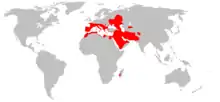Kuhl's pipistrelle
Kuhl's pipistrelle (Pipistrellus kuhlii) is a species of vesper bat that lives over large areas of North Africa, southern Europe and Western Asia.[1] It can be found in temperate forests, subtropical or tropical dry shrubland, Mediterranean-type shrubby vegetation, temperate grassland, rural gardens, and urban areas.
| Kuhl's pipistrelle | |
|---|---|
 | |
| Scientific classification | |
| Kingdom: | Animalia |
| Phylum: | Chordata |
| Class: | Mammalia |
| Order: | Chiroptera |
| Family: | Vespertilionidae |
| Genus: | Pipistrellus |
| Species: | P. kuhlii |
| Binomial name | |
| Pipistrellus kuhlii Kuhl, 1817 | |
 | |
| Global range of P. kuhlii (red) | |
| Synonyms | |
|
Vespertilio kuhlii Kuhl, 1817 | |
Taxonomy
Kuhl's pipistrelle was first named in 1817, under the name Vespertilio kuhlii, in a work by Heinrich Kuhl entitled Die deutschen Fledermäuse ("The bats of Germany").[2] The specific epithet was chosen by Johann Natterer, who had collected the first specimens, and commemorates Kuhl; under the rules of the ICZN, however, Kuhl himself is regarded as the authority, as the first to report the name.[3]
The population of Algeria, Egypt, Libya, Sudan was formerly known as Pipistrellus deserti.[4] This taxon is now considered to be a junior synonym of Pipistrellus kuhlii[5]
References
- Juste, J.; Paunović, M. (2016). "Pipistrellus kuhlii". IUCN Red List of Threatened Species. 2016: e.T17314A22132946. doi:10.2305/IUCN.UK.2016-2.RLTS.T17314A22132946.en.
- Heinrich Kuhl (1817). Die deutschen Fledermäuse [The bats of Germany] (in German). Hanau.
- Charles Klaver (2007). Inseparable Friends in Life and Death: Heinrich Kuhl (1797–1821) and Johan Conrad Van Hasselt (1797–1823), Students of Prof. Theo Van Swinderen. Biografieën van Groningse hoogleraren. Barkhuis. p. 93. ISBN 9789077922316.
- Benda, P. 2004. Pipistrellus deserti. 2006 IUCN Red List of Threatened Species. Downloaded on 19 July 2007.
- Petr Benda; Tommy Andriollo; Manuel Ruedi (November 2015). "Systematic position and taxonomy of Pipistrellus deserti (Chiroptera: Vespertilionidae)". Mammalia. 79 (4): 419–438. doi:10.1515/MAMMALIA-2014-0024. ISSN 0025-1461. Wikidata Q37147763.
